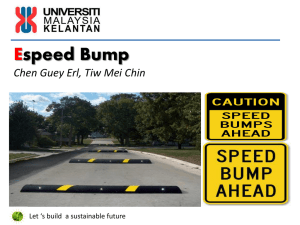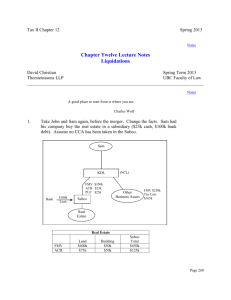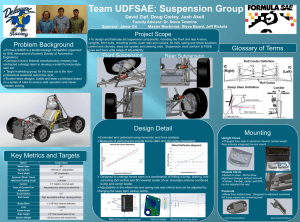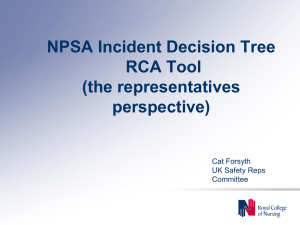The 88(1)(d) Bump - Mining Tax Canada
advertisement
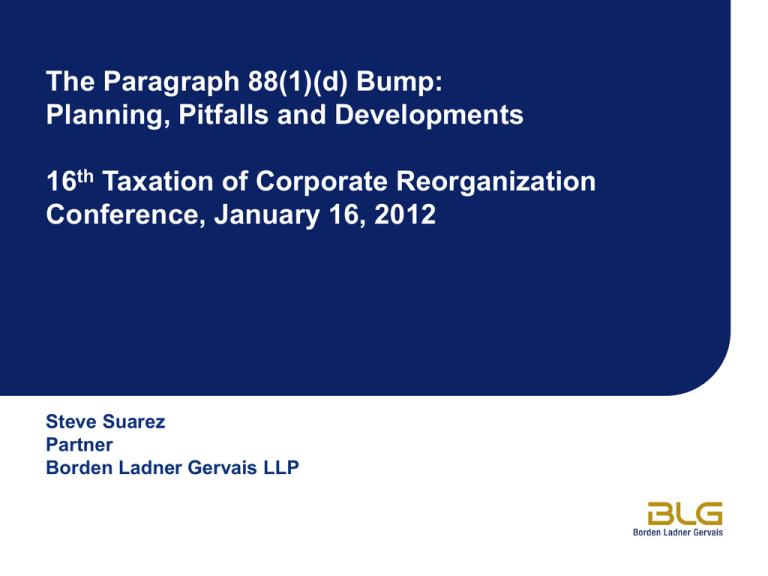
The Paragraph 88(1)(d) Bump: Planning, Pitfalls and Developments 16th Taxation of Corporate Reorganization Conference, January 16, 2012 Steve Suarez Partner Borden Ladner Gervais LLP Issues Covered • Bump Overview/Recap • Role of Bump in Acquisition Planning • Supporting Rules: 88(1.7), 88(1)(d.2) and 88(4) • Bump Denial Rule: 88(1)(c)(vi) • Late/Amended Elections • Foreign Affiliates 2 Bump Overview/Recap 88(1)(d) bump permits one taxable Canadian corporation (parent) to increase the cost of non-depreciable capital property acquired from another taxable Canadian corporation (subsidiary) on a qualifying wind-up or amalgamation of subsidiary into parent Relevant provisions • • • • 88(1)(c): 88(1)(d): 88 various: 87(11): entitlement computation supporting/interpretational rules amalgamation equivalence 3 Bump Overview/Recap Figure 1. Basic Bump Transaction 1. Acquisition of CanCo 2. Wind-Up of CanCo CanAcquireCo (Parent) Seller CanAcquireCo Tax cost = $100 FMV = $100 $100 Tax cost/ FMV = $60 CanCo (Subsidiary) Tax cost = $20 FMV = $60 Eligible Propert y Tax cost = $30 FMV = $40 CanCo Tax cost = $30 FMV = $40 Eligible Property Other Property Other Property 4 Bump Overview/Recap 88(1)(c) mid-amble: subsidiary property ownership requirement 88(1)(c)(iii): depreciable property exclusion 88(1)(c) (iv): anti-butterfly rule 88(1)(c) (v): anti-stuffing rule 88(1)(c)(vi): bump denial rule 5 Bump Overview/Recap 88(1)(d) Bump Parent can increase tax cost of Eligible Property distributed by Subsidiary to Parent on Wind-up Qualifying Wind-Up - Canadian corporation (Subsidiary) merges or winds up into a Canadian corporation (Parent) that is its 100% shareholder Limit on Bump Amount - Individual property limit: property’s tax cost cannot be increased above its FMV at time of AOC (plus new limit for foreign affiliate shares) - Aggregate bump limit: Parent’s tax cost of Subsidiary shares minus (1) net tax cost of Subsidiary’s assets and (2) Subsidiary dividends to Parent Eligible Property - Nondepreciable capital property (e.g., land, shares) - Owned directly by Subsidiary at time of AOC - Held continuously by Subsidiary until Wind-up - Not acquired from Parent (or NAL person) as part of AOC Series - Not distributed to Parent on a “butterfly” reorganization Bump Denial Rule - No 88(1)(d) bump on any property if a “prohibited person” (e.g., former Subsidiary shareholders) acquires “prohibited property” (e.g., property distributed by Subsidiary to Parent on the Wind-up) as part of the AOC Series 6 Role of Bump in Acquisition Planning Various situations in which an acquiror will find an 88(1)(d) bump of target’s eligible property to be useful • • • • sale of target property to third party to help finance the acquisition (eg. Placer Dome/Barrick/Goldcorp) sale of target property to meet competition law divestiture requirements internal post-closing restructuring (e.g., extraction of target’s foreign subsidiaries) unplanned but eventual sale of target property “Pre-packaging” of property by target often extremely helpful 7 Role of Bump in Acquisition Planning 1. Post-Canco Wind-Up and Bump 2. CanAcquireCo Capital Return U.S. Parent U.S. Parent Tax cost = $100 FMV = $100 Tax cost/ FMV = $60 CanAcquireCo US SubCo (Parent) Tax cost / FMV = $60 US SubCo Tax cost = $30 FMV = $40 Other Propert y Tax cost = $40 FMV = $40 CanAcquireCo Tax cost = $30 FMV = $40 Other Propert y 8 Role of Bump in Acquisition Planning While highly useful, the 88(1)(d) bump is best thought of as one of a number of tools for managing tax issues on an acquisition. There may be other alternatives available that do not have comparable limitations or eligibility restrictions, or which can supplement bump planning • use of losses within the target group: loss carryforwards from prior years, current year losses, or losses triggered under deemed tax acquisition of control write-down • pre-acquisition reorganizations to match gains to losses and optimize use of 111(4)(e) often very valuable 9 Role of Bump in Acquisition Planning • where target has foreign affiliates, existence of available surplus balances, subject to new change-of-control writedown rule in Regulation 5905(5.2), reducing top-tier FA’s exempt surplus balance to the extent that ACB of FA shares (after applying 111(4)) plus FA’s tax-free surplus balance exceeds FMV of FA shares (discussed below in Foreign Affiliate section) • where target has foreign affiliates, 95(2)(f.1), which carves out of FAPI amounts accrued in respect of property or a business during a period when no person holding the property or carrying on the business was a “specified person or partnership” in respect of the Canadian taxpayer owning the FA shares • Useful provision for dealing in inherited FAPI; highly technical 10 Supporting Rules: 88(1.7), 88(1)(d.2) and 88(4) 88(1.7): a very important provision that contains a number of planning pitfalls Where Parent deals NAL with another person (other than a corporation Parent acquired control of from an arm’s length person) any time pre-wind-up, Parent and that person are deemed never to have dealt at arm’s length Relevant to: • 88(1)(c)(v) • 88(1)(d)(i.1) anti-stuffing rule bump computation 11 Issues with 88 (1.7) 1. Public Pubco dividends Subco Property 2. Buyer Pubco Subco Property Buyer acquires Pubco from the public, winds 3. up Pubco and Subco, and seeks to bump Property. Prior to the acquisition Subco paid dividends to Pubco Because Buyer deals not at arm’s length with Pubco post-acquisition, 88(1.7) would deem Buyer and Pubco never to have dealt at arm’s length, unless the parenthetical exception applies → Subco dividends received by Pubco would reduce bump room under 88(1)(d)(i.1) Q: did Buyer acquire control of Pubco from “a person”? A: yes, on a contextual and purposive reading of 88(1.7), 88(1)(c) and 88(1)(d), parenthetical exception applies CRA document 2011-0418971E5 Buyer Property 12 Issues with 88 (1.7) 1. Target Bump Property 2. Pre-packaging situations: Interaction of 88(1)(c)(v) and 88(1.7) can create problems where pre-packaging is accompanied by post-AOC drop-down Target Subco Pre-acquisition of control, Target transfers Property to Subco for Subco shares as part of a prepackaging Bump Property 13 Issues with 88 (1.7) 3. Buyer Post-acquisition of control, Buyer transfers Target to Newco for Newco Shares Target Newco winds up Target and wants to bump Subco shares Subco Bump Property Problem: Newco (parent) did not deal at arm’s length with Subco post-AOC, so 88(1.7) deems them never to have dealt at arm’s length (parenthetical N/A because Newco acquired control of Subco from Buyer) → Target (subsidiary) acquired Subco shares from a person (Subco) deemed to deal NAL with Newco (parent) 4. Buyer Newco Target Subco Bump Property → Subco shares ineligible under 88(1)(c)(v) 14 Issues with 88 (1.7) Target 88(1.7) can also produce anomalous results in bump computation where pre-acquisition dividends were paid within Target group Buyer Subco 1 Target Subco 2 Subco 1 Buyer acquires Target Property Subco 2 Property 15 Issues with 88 (1.7) Buyer Post-acquisition of Target, Buyer drops Target down into Newco for Newco shares Buyer Newco Newco winds up Targetco, Subco 1 and Subco 2, and wants to bump Property Newco Target 88(1.7) applies to deem Newco never to have dealt at arm’s length with Targetco, Subco 1 or Subco 2 (paranthetical NA because Newco acquired control of Target from Buyer) Subco 1 Subco 2 Property Property → pre-acquisition dividends from Subco 2 to Subco 1 and from Subco 1 to Target reduce the bump under 88(i)(d)(i.1) See CRA documents 2007-0243261C6 and 9513425 16 Issues with 88 (1.7) 1. Target Property Target 2. The interaction of partnerships with 88(1.7) also carries interpretational issues Pre-acquisition, Target creates Subco, forms a partnership and transfers Property down to Partnership Buyer acquires Target Subco 99% Buyer 3. Target Subco 99% 1% Partnership 1% Partnership Property Property 17 Issues with 88 (1.7) 4. Subco Buyer Buyer winds up Target and seeks to bump 99% Partnership interest 99% Target (subsidiary) acquired Partnership interest (distributed property) from Partnership 1% Partnership Property 88(1)(c)(v) deems ineligible property acquired from a person or partnership not dealing at arm’s length with Target (subsidiary) Does 88(1.7) deem Target and Partnership never to have dealt at arm’s length, so as to disqualify Partnership interest? (note that parenthetical carve-out limited to corporations) No: 88(1.7) refers only to “another person”, not “person or partnership” (see CRA document 2006-0212691R3) 18 Issues with 88 (1.7) 1. Partnership Partnership as the vendor of Target instead of the vendor of bump property: 3. Buyer Target Target Property 2. Partnership Target Subco Target transfers Property to Subco for Subco shares Subco Buyer acquires control of Target from Partnership Property Q: if “person” in 88(1.7) does not include a partnership, does that mean that where control of a corporation is acquired from a partnership, the parenthetical exception in 88(1.7) cannot apply? 4. Buyer Subco Property Property 19 Issues with 88(1)(d.2) 88(1)(d.2): Time of AOC Where Acquirer acquired control of Subsidiary from NAL person, time at which Acquirer last acquired of control of Subsidiary backdated to NAL person’s acquisition of control Relevant to: • • • • 88(1)(c) mid-amble 88(1)(c)(v) anti-stuffing rule 88(1)(c)(vi) bump denial rule 88(1)(d)(ii) maximum bump computation 20 Issues with 88(1)(d.2) 88(1)(d.2) potentially backdates acquisition of control • 88(1)(d.2) In determining, for the purposes of this paragraph and paragraphs (c) and (d), the time at which a person or group of persons (in this paragraph and paragraph (d.3) referred to as the “acquirer”) last acquired control of the subsidiary, where control of the subsidiary was acquired from another person or group of persons (in this paragraph referred to as the “vendor”) with whom the acquirer was not (otherwise than solely because of a right referred to in paragraph 251(5)(b)) dealing at arm’s length, the acquirer is deemed to have last acquired control of the subsidiary at the earlier of 21 Issues with 88(1)(d.2) (i) the time at which the vendor last acquired control (within the meaning that would be assigned by subsection 186(2) if the reference in that subsection to “another corporation” were read as “a person” and the references in that subsection to “the other corporation” were read as “the person”) of the subsidiary, and (ii) the time at which the vendor was deemed for the purpose of this paragraph to have last acquired control of the subsidiary 22 Issues with 88(1)(d.2) 88(1)(d.2): Time of AOC • CRA document 2006-0174021C6: “we agree that the wording of paragraph 88(1)(d.2) makes it somewhat difficult to ascertain what the appropriate result should be in all circumstances” • 256(7) deeming rules not applicable • 88(1)(c.6): plan of arrangement • 88(1)(d.3): control acquired due to death 23 Issues with 88(1)(d.2) 1. Taxpayer Subco Property 2. Estate ACB = FMV Subco Property Interaction of 88(1)(d.2) and (d.3) can be helpful in post-mortem situations where (d.2) might otherwise deem control to have been acquired at an earlier time when subsidiary (Subco) may not have owned distributed property (Property) or when its value was considerably lower Estate deemed to acquire Subco shares at FMV on Taxpayer’s death; on subsequent transfer of Subco shares to Newco and wind-up of Newco, bump of Property depends on whether (d.2) deems parent (Newco) to have last acquired control of Subco when deceased Taxpayer acquired control of Subco 24 Issues with 88(1)(d.2) 3. Estate Newco 3. Subco Property 4. Estate Newco Property Estate wants to transfer Subco shares to Newco, wind-up Subco and bump Property Q: When is Newco deemed to have last acquired control of Subco: when deceased Taxpayer acquired control of Subco or when Estate acquired control of Subco? If former, (c) mid-amble may prevent bump of Property or (d)(ii) may reduce bump A: CRA accepts that interaction of (d.2) and (d.3) is that Newco last acquires control of Subco immediately after Taxpayer’s death (i.e., when Subco owned Property and Property FMV was high) CRA document 2011 – 0391821E5 25 Issues with 88(4) 88(4): Amalgamations For purposes of 88(1)(c), (c.2), (d) and (d.2), including paragraphs (c.3) – (c.8) and (d.3) • no acquisition of control • Amalco the same as, and a continuation of, each predecessor • creates interpretational issues as to when control acquired and when property acquired 26 Issues with 88(4) Questions when amalgamating and relying on 88(4) • which predecessor is relevant for determining when control of Amalco was last acquired (or when Amalco last acquired control of another corporation)? • relevant to (c) mid-amble, (c)(v) and (d)(ii) • which predecessor is relevant for determining “specified shareholder” and “specified person” status of Amalco? • relevant to bump denial rule • is Amalco deemed to have owned each property during the period in which its predecessors owned its properties? • relevant to (c) mid-amble and (d)(ii) • which predecessor is relevant for purposes of (c.4) “specified property analysis”? • relevant to bump denial rule 27 Issues with 88(4) 1. Buyer Public Subco 2. Target Buyer Public preferred Amalco 3. Buyer Public Amalco $ Note that because 88(4) deems no acquisition of control to have occurred on an amalgamation, bump acquisitions must be structured so as to include a discrete acquisition of control of Target: Otherwise Buyer has technical issues under (c) mid-amble (capital property at time parent last acquired control of subsidiary) or (d)(ii) (bump can’t increase ACB above FMV of property at time parent last acquired control of subsidiary) 28 Issues with 88(4) 1. Target Subco Property • Parent creates Acquisco, which acquires Target Property 2. • Target amalgamates with Subco to form Amalco 1 Parent Acquisco • Acquisco amalgamates with Amalco 1 to form Amalco 2 Target Subco While 88(4) involves some interpretational uncertainty, to date CRA has taken a practical and helpful approach Property Property 29 Issues with 88(4) 3. Parent Acquisco Amalco 1 Property 4. Parent Amalco 2 CRA document 2007-0240271R3: • 88(4) does not cause Target or Subco (as predecessors of Amalco 2) to be considered to have acquired Amalco 1’s property in such a way as to invoke the bump denial rule • Amalco 1 will be considered to be the same corporation as (and a continuation of) Target and Subco for purpose of (c) midamble (i.e., how long has Amalco 1 held the property to be bumped) Property 30 Issues with 88(4) 1. TCC Public 2. Public Minority (<33%) TCC >67% Parent Target Parent Target Subco 1 Subco 1 Subco 2 Subco 2 CRA document 2002-0130715 Taxable Canadian corporation (TCC) creates Parent, and they jointly offer to purchase all of the shares of Target in exchange for TCC shares. More than 2/3 but less than 90% of Target shareholders tender their shares. 31 Issues with 88(4) 3. Other Public TCC Public Minority (<33%) Parent Newco >67% Target Subco 1 Subco 2 TCC and Parent transfer the Target shares they have acquired to Newco for Newco shares. 32 Issues with 88(4) Alternative 1 a) TCC Parent Public Minority Other Public 100% common redeemable preferred Amalco Newco, Subco1 Subco2 and Target amalgamate to form Amalco, with the Public Minority receiving redeemable preferred shares that are then redeemed. Parent and Amalco amalgamate to form Amalco 2. Bump denial rule would apply unless TCC shares are considered to be shares acquired by Public in exchange for shares of the bump subsidiary (Amalco) under (c.4) (iii). 33 Issues with 88(4) Alternative 1 Public b) Public TCC TCC Parent Amalco 2 Amalco CRA agrees that “when interpreting ss. 88(4), the corporation formed as a result of an amalgamation is deemed to be the same corporation as, and a continuation of, the predecessor relevant to that situation, having regard to all the circumstances…” In this case, TCC shares would be considered to be shares acquired in exchange for shares of the bump subsidiary, because 88(4) would deem Amalco to be the same corporation as Target, so that (c.4) (iii) applies. For purposes of determining whether the bump subsidiary (Amalco) owned the bump property when control of Amalco was last acquired (i.e., the (c)(v) mid-amble), Subco 2 would be the relevant predecessor 34 Issues with 88(4) Alternative 2 a) TCC Parent Public Minority Other Public 100% common redeemable preferred New Target Subco 1 Subco 2 Newco and Target amalgamate to form New Target, with the Public Minority receiving redeemable preferred shares that are then redeemed. New Target, Subco 1 and Subco 2 amalgamate to form New Target 2. Parent and New Target 2 amalgamate to form New Target 3. 35 Issues with 88(4) Alternative 2 Public b) Public Public TCC TCC TCC Parent Parent New Target 3 New Target New Target 2 Subco 1 Subco 2 For purposes of the bump denial rule, TCC shares acquired by Public in exchange for their Target shares will be considered to be shares acquired in exchange for shares of the bump subsidiary (New Target 2), so as to be (c.4) (iii) specified property For purposes of the (c) mid-amble, the bump subsidiary will be considered to be the same corporation as (and a continuation of) Subco 2 in determining whether the bump property was owned by the bump subsidiary when Parent last acquired control of New Target 2 36 Bump Denial Rule • The bump denial rule in 88(i)(c)(vi) completely denies the bump on all of the subsidiary’s property distributed to the parent if applicable. Paraphrased, it applies if restricted people acquire restricted property as part of the relevant series of transactions • Restricted (1) pre-AOC specified shareholders of the people subsidiary (2) any aggregation of persons whose shares, if held collectively by one person, would make that one person a pre-AOC specified shareholder of the subsidiary 37 Bump Denial Rule (3) certain corporations in which persons described in (1) or (2) are (or would be) specified shareholders post-AOC • Restricted property (1) distributed property (2) property acquired in actual substitution for distributed property, unless excluded under (c.3)(iii) – (vii) (3) (c.3)(i)/(ii) deemed substituted property, unless excluded under (c.3)(iii) – (vii) or (c.4) 38 Bump Denial Rule Several comfort letters reducing scope of restricted property • under 1 September 2006 comfort letter, (c.3)(iv) exception for substituted property not owned by restricted person any time post-acquisition of control will be extended to distributed property • various comfort letters allow cash and/or shares of Canadian acquiror delivered on redemption of preferred shares on amalgamation squeeze out • other comfort letters allow options and warrants of Canadian acquiror to be delivered in exchange for target options and warrants 39 Bump Denial Rule Other important CRA limitations on scope of restricted property • earn-out clauses used solely to establish fair market value of shares (CRA document 1999-0010965) • price adjustment clauses providing post-closing adjustments to ensure purchase price reflects exact amount of liability at closing (CRA document 2007-0243261C6) • seller parent guarantees of seller obligations (CRA document 2009-0340351R3) 40 Bump Denial Rule 1. Specified Shareholder $ Target Property 2. Specified Shareholder Property Target Limitations on property acquired “in substitution for” distributed property Prior to Buyer purchasing Target and winding it up, Target sells property to a specified shareholder for cash Post-acquisition, Target cash is distributed to Buyer on bump windup of Target Is property acquired by specified shareholder acquired “in substitution for” distributed property (Target cash)? CRA: generally, no in these circumstances (CRA document 2007-0243261C6) $ 41 Bump Denial Rule 1. Limitations on property acquired “in substitution for” distributed property Mr. X Target Target transfers Property to Newco for Newco Shares Property 2. Mr. X Target Newco Property Newco is a specified shareholder of Target by virtue of dealing non-arm’s length with Mr. X Buyer Buyer buys Target; Target wound up: Buyer seeks to bump Newco shares (distributed property) Is Property (acquired by Newco, a specified shareholder) property acquired in substitution for distributed property (Newco shares)? Generally no (even though the reverse is not so), because Newco doesn’t own its own unissued shares: CRA document 9821355 42 Bump Designation and Late Filing Where bump designation is not filed within the prescribed time period, CRA has indicated that it will administratively allow a late-filed bump designation under the following circumstances (CRA document 2011-0416881E5): 1. either the aggregate available bump is allocated amongst bump-eligible properties pro rata to the available bump room for cash property, or the taxpayer allows the CRA to make the allocation 43 Bump Designation and Late Filing 2. no late-filing will be accepted that (1) amounts to retroactive tax planning, (2) is part of a tax avoidance strategy, or (3) requires reassessment of a statute-barred year to give effect to the designation • • for purposes of (3), while it is not necessary to reassess to give effect to a designation that has no impact on the computation of the parent’s income for the year, it is necessary to reassess a year in which the relevant property is disposed of (no late filing permitted if that year is statute-barred) this means that it may be possible to late-file a designation in respect of some bump-eligible properties but not others 3. no particular policy on number of years passed since liquidation of subsidiary 44 Foreign Affiliates TFSB = $1,400 Under August 27, 2010 amendments, 88(1)(d)(ii) will be amended to reduce the extent to which shares of a foreign affiliate of the bump subsidiary may be bumped, based on the “prescribed amount” in Regulation 5905(5.4). Exempt surplus = $700 In addition, draft Regulation 5905(5.2) may apply on an acquisition of control of a Canadian corporation that has one or more foreign affiliates, to reduce the exempt surplus balance of top-tier foreign affiliates (i.e., those held directly by the Canadian target). Can Target FMV = $800 Other Property FMV = $1200 ACB = $300 FA 1 FA 2 Exempt surplus = $700 Objective is to prevent perceived duplication of favourable tax attributes 45 Foreign Affiliates: Regulation 5905(5.2) In general, the effect of draft Regulation 5905(5.2) is to reduce the foreign affiliate’s exempt surplus balance to the extent that: 1. the foreign affiliate’s “tax-free surplus balance” in respect of Canadian target (essentially consolidated exempt surplus plus grossed-up underlying foreign tax on taxable surplus) plus 2. Canadian target’s ACB of the foreign affiliate’s shares immediately before the acquisition of control (after taking 111(4) into account) exceeds 3. the fair market value of Canadian target’s shares of the foreign affiliate 46 Foreign Affiliates: Regulation 5905(5.2) Can Acquisition ACB/FMV = $2,000 Can Target FMV = $800 Other Property Reduced TFSB = $900 FMV = $1200 ACB = $300 FA 1 Example: if Can Acquisition acquires Can Target for $2,000, draft Regulation 5905(5.2) reduces FA 1’s exempt surplus by ($1,400 + $300) - $1,200 = $500 Result: “good” surplus plus ACB in top-tier FA cannot exceed fair market value of FA Reduced exempt surplus = $200 FA 2 Exempt surplus = $700 47 Foreign Affiliates: Regulation 5905(5.4) If Can Acquisition then winds up Can Target and claims an 88(1)(d) bump of FA 1 shares, draft Regulation 5905(5.4) reduces the amount of any bump by the amount of FA 1’s TFSA as computed following the application of the Regulation 5905(5.2) exempt surplus grind (i.e., $200 + $700 = $900) 88(i)(d)(ii) provides that bump amount on FA 1 shares cannot exceed amount by which the FMV of FA 1 shares ($1,200) exceeds the sum of (1) Can Target’s ACB of FA 1 shares ($300) plus (2) Regulation 5905(5.4) prescribed amount ($900) Bump permitted = 1,200 - (300+900) = 0 Thus, post-acquisition of control, the sum of Can Acquisition’s ACB of shares of an FA and the FA’s TFSB cannot exceed the FMV of the FA’s shares 48 Foreign Affiliates: Regulation 5905(5.4) Can Acquisition FMV = $800 Other Property FMV = $1200 ACB = $300 Conceptually, if Can Acquisition were to dispose of FA 1 shares immediately post- acquisition, there should be no gain through the use of ACB of $300 and TFSB (via the use of s. 93) of $900 FA 1 Exempt surplus = $200 FA 2 Exempt surplus = $700 However, if future losses reduce FA 1’s TFSB, there may be a gain consider an internal transaction to crystallize surplus into basis (e.g. sale of FA shares to Canadian sisterco for a note) 49 Foreign Affiliates: Regulation 5905(5.4) Where Can Target purchaser is a foreign corporation, the objective will often be to extract Can Target’s FAs out of Canada, such that duplication of Canadian tax attributes is irrelevant and there is no point in imposing the administrative burden of computing TFSB and Regulation 5905(5.4) bump reduction at 2011 IFA Round Table, CRA agreed to forego TFSB calculation where FA shares are transferred up and out of Canada within a reasonable time post-takeover, there is otherwise sufficient bump room to bump FA shares to fair market value, and no FA dividends are received by Can Target or Can Acquisition post-takeover (CRA document 2011-0404521C6) 50 The End Thank you Steve Suarez Borden, Ladner Gervais LLP (Toronto) 416 367-6702 ssuarez@blg.com #4812038 51
